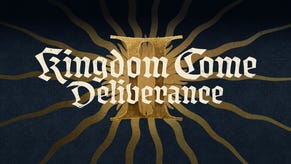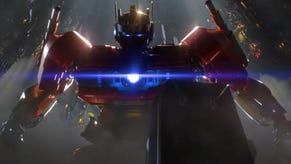id boss Todd Hollenshead - the ultimate interview
Interview by Nathan Grayson.
When we say "ultimate," we don't mean he's going to die next week. No sir. Todd Hollenshead, id Software's inimitable CEO, is very much alive. We know, because Nathan got to quiz him on DOOM 4, RAGE, next gen consoles and so much more at QuakeCon earlier this month.
No stones were left unturned. Todd bore all. Hit the link if you don't believe us.
VG247: RAGE is a post apocalyptic open-world title. So are games like Borderlands and Fallout 3. What would you say separates your take on the sub-genre from others?
Todd: Hollenshead: I wouldn’t really call it open-world, because I think that has sort of a different connotation than the gameplay experience we’re going for, which we like to think of as open-but-directed. So it’s not like “do whatever you want at all times.” We try to give people a little more direction in terms of what’s going on in the game. There’s story, there’s characters we like to introduce. There are certain elements of progression in the game. I mean, people will have the freedom to get themselves into more trouble than they can handle before they’re ready for it, so that’s kinda the open aspect of it.
The way RAGE works is that we want to create experiences for the player that we think are cool and fun; we want to make sure the player is directed to do those sorts of things, as opposed to games where you may miss a big part of the game because you didn’t realize you had to take a certain path. Some games are designed where the whole open aspect of it is sort the core game design principle. And that’s why I say it’s different with RAGE. We do allow the player tons of freedom; you’re not on a rail going through the world. You can do things in different orders, and there’s stuff you can do in-between. But we try to make sure that you see and experience the stuff that is really cool.
So, what would you say to the people who compare RAGE to Borderlands or Fallout?
Todd: Hollenshead: Well, I haven’t seen Borderlands. I mean, I’ve only seen screenshots of it. I haven’t played it. I don’t know what they’re using as a basis of comparison. I don’t have one, but – from what I’ve seen -- my take on it is that they’re probably quite different games. But that’s just a guess.
Fallout’s an interesting comparison. I think there is sort of the post-apocalyptic thing, but there are tons of different ways in which that can be explored. You know, Mad Max was in many ways post-apocalyptic and it had cars and stuff like that. So when I describe [RAGE] to someone who has never seen an image of it or something like that, I’d say it’s like a videogame-meets-Mad Max, because in many ways, cities cobbled together and stuff like that establishes more of an image in the mind of somebody your describing it to.
Whereas Fallout is really a true RPG, and RAGE has some elements that are similar to that in terms of the items you can find and the interesting things you can do with them, and schematics to make things – that sort of stuff. But RAGE really is an action game at its core. There are some driving and racing elements in it. There are some story elements that maybe get just on the fringe of the role-playing aspect of it, but at its core it really is a new way of doing the things we’ve always done and done best – I think – for a long time.
You couldn’t show DOOM 4 this year, obviously. Any specific reason for that?
Todd: Hollenshead: We just never had anything prepared to show for it. It wasn’t like we were going to, and then decided not to. It’s just that the idea is that we want game development to get far along enough that we have something that we feel is representative of a game that we’re going to make and what the final game is going to be. I can say a lot of things about what the game is intended to be like, but if I say those things without a picture or an image – something to back up that this is what it is – then if there are one hundred people in the room, they’re all going to have one hundred different mental pictures above their heads. So that’s really the reason we’re not talking about it. We want to have something that says, “This is what the game is about and this is what the game is, and here you can see it for yourself.” And we’re just not to that point yet.
So basically, you’re not pulling a Peter Molyneux.
Todd: Hollenshead: [Laughs]. I’d say we’re taking the id approach, which is that we really work to a quality standard, and when the game is fleshed out enough and has the elements that we think demonstrate what the game is about, then we’ll talk about it, and then we’ll show it. Plus, we have a lot of stuff to talk about that’s coming well before the Doom stuff. And it probably makes more sense to talk about it at QuakeCon next year, given that we’ve got Wolfenstein and RAGE. So I think Doom sort of deserves its own spotlight.
John Carmack has – on a few occasions – mentioned the game id was working on before you decided to scrap it and give RAGE your full attention. It was titled “Darkness.” Why did you cancel that in favor of RAGE?
Todd: Hollenshead: Well, there are a couple of things here. First of all, when John started up the [id Tech 5] technology, he kind of had an original direction in his mind about what the technology was going to be like. And we had some ideas about what a good game that’d work with that tech might be like. But some of the technical stuff actually changed, so the game design didn’t quite fit as well as we thought it would originally. We really didn’t expect the ability to have the massive texturing and the outdoor environments; the game wasn’t designed or conceived to take advantage of that. So we were like, “Not taking advantage of this technology would be a shame.”
But the other factor was that because of the way the business is run – the way game development progresses at id – in such a way that if we like something and it’s going well, we’ll continue to do it. And if we have other good ideas, we’ll implement them, and if there are ideas we don’t like, we’ll scrap them and replace them with something else or just pull them out of it entirely. With [Darkness], we weren’t satisfied with where the game ultimately was. You know, we thought it would be good, but we weren’t convinced that it was going to be great. And so we thought about different stuff we could do – stuff that fit better with the technology, that was more exciting for us, that we thought would make a better game.
Carmack also mentioned that he was disappointed that id isn’t developing anything for the Wii. Obviously, that’s because you guys are on the bleeding-edge technology-wise, and the Wii’s not. So what about Microsoft’s Project Natal and Sony’s upcoming motion doohickey? Is id looking into those at the moment?
Todd: Hollenshead: As far as I know, the answer’s “no.” I haven’t seen anything come into the office, but honestly that’s more at the John [Carmack] and Robert [Altman] level. That is, whether or not they’ve been talking with Microsoft or Sony guys. I’m not aware if they have or they haven’t. I mean, it’d probably surprise me if John hasn’t had some discussions with them, but I don’t think we have any sort of serious internal development effort going towards exploiting those [motion controllers]. Right now, we’re focused on getting Quake Live to final, finishing the development of RAGE, and then getting Doom to a point where we’re ready to show it off.
Back to RAGE – will there be any sort of demo or open beta before the game releases?
Todd: Hollenshead: I doubt there will be an open beta.
The demo question is hard to answer, because I don’t know what the development cycle will be like. We don’t have anything against demos or tests; we typically do that – probably – to a greater extent than almost anybody else in the industry, so my guess would be that we will have something, but that’s far from set in stone. I mean, there could be different things on different platforms. There could be something that’s more along the lines of a PC demo or maybe a Mac demo that comes out from a test perspective. But really, at this point, that’s speculation.
RAGE has been declared a multi-platform title, which is a major break from id’s PC-centric past. Do you think there’s a place for PC exclusives if your name isn’t Blizzard or Valve?
Todd: Hollenshead: I certainly hope there’s a place for PC-only games, because if there’s not, then Quake Live is not moving to survive and be successful.
Speaking of Quake Live, John Carmack announced that the game’s next big upgrade will be the addition of a premium subscription option. In general, do you think there’s a future for games that are purely ad-supported and free-to-play, or do you think subscription models and/or microtransactions are required?
Todd: Hollenshead: I think the jury is out on that, to be honest. In my opinion, Quake Live is a litmus test, because it’s a quality game; I love it – I know the perception of it in public is that it’s an excellent game. We don’t like the idea of putting in microtransactions that impact gameplay balance. Because that is antithetical to what Quake Live is about, which is that it’s a [skill-based] game. We don’t like to have an “I’m willing to spend the most money, therefore I win” kind of thing that’ll get me the best weapon and that’ll get me an advantage that’s unfair. We want the Quake 3 kind of thing where it’s the player with the most skill that wins the match.
Really though, since we first started talking about the game, but especially recently, [pertaining to] the premium level of services that we’re talking about, the subscription isn’t really a subscription to get aspects of the core game that you wouldn’t otherwise get for free. It’s more to get things that are service or feature-oriented. The specific thing is server rental and being able to start playing whatever map you want to and kick whoever you want to off the server or whatever. But those things aren’t gonna count for leaderboards or stats or things like that. That’s just like planned server rentals or tournament server rentals – those sorts of things.
And, because of the way we have the infrastructure set up, those sorts of things can be dynamically brought up and taken offline. It’s actually more efficient for us to do that in the way we have Quake Live running than it is for people to go to the server rental farms and pay $20 a month – or I heard that some of them are as much as $30 or $50 per month depending on where you are. So we think we can do that far more cost effectively, and actually add a higher level of service because it’s completely dynamic. It’s an incremental cost for us that we’ve got to charge for, but we think we can deliver value there that exceeds what people are required to pay.
id was recently purchased by Zenimax, an event that many called “the end of an era.” With developers like id, Blizzard, and BioWare hooking up with major publishers, it sort of seems like the days of triple-A independent development are at an end. Would you say that’s a fair assessment? Do you think independent development’s all about smaller, more financially feasible games now?
Todd: Hollenshead: The problem with independent game development – at least from our perspective – is that you have a few issues. For one, you have consolidation within publishers, so you have a narrower and narrower choice of publishers with which to publish. And in our specific case, most of the publishers that were out there all had titles or teams that were internal that were in sort of our competitive area of shooters. So that created a natural conflict, especially when they were slated to come out in similar time windows. That was becoming a larger and larger concern for us. Also, the declining number of companies that we could work with – just because of companies going out of business or being bought, acquired, merged, etc. – was becoming a concern as well.
For us, we know game development, but we’re not publishing experts. That’s why we partner with publishers to do it as opposed to self-publishing our stuff. So from our point of view with the merger, yes id was acquired, but id also acquired a publisher that has top-notch capabilities, that has been recently proven through what they’ve done with Fallout 3. We think that the combination of the two companies was an amazingly perfect fit with almost no overlap, with guys that we liked! I mean, Todd Howard is – and I don’t use this loosely – one of the most brilliant minds in the videogame business, and we have a ton of respect for those guys. And Todd can bring out his “Charter Member of the id Fan Club” card and show it to you with authority, so Zenimax had a ton of respect for us. So for us, it made a lot of sense.
Now, not everyone is going to be in a similar situation to that. So I wouldn’t that every independent developer needs to be acquired by a publisher or something like that, because everybody’s situation is a little bit different. But, you know, ten years ago, you sold one million copies of a game and it was a huge mega-hit. Today, it literally has changed by an order of magnitude. If you want a huge mega-hit, that’s not a million-seller. It’s a ten million unit seller. And to make a game that sells ten million units not only requires a lot more development time and effort to be put in the game – it requires other financial considerations as well. You have to have a huge inventory filled to be able to sell that many copies and have them stocked at retail; you gotta spend tens of millions of dollars (or more!) – I mean, it’s anyone’s guess on how much Microsoft spends marketing Halo – but I have seen hundred million dollar figures bandied about. So you’ve gotta spend huge money marketing a title.
And when you take all those things into account, an independent, internally-funded developer is almost too much to ask for. Could they go borrow the money – could they partner with someone to get the money – to do that? Yeah. But then you start diluting your decision-making authority, because now [the potential partner] gets a seat at the decision-making table. And that was another thing that we never thought was a good option: to have someone else making the decisions about the games that we’re making. And really, our relationship with Zenimax is that we’ll make all the game development decisions. We’ll tell Zenimax what those decisions are so they’ll know, so they can help us with marketing and things like that – and if they think we’re making a boneheaded decision, they can tell us. But, by and large, they don’t want to get involved in that because they don’t want to mess up the recipe of what has been successful for so long. It’s just like how we have respect for Zenimax on the publishing side. I mean, we’re not going to go in and tell them, “Hey, here’s my crazy developer idea about how you ought to change the way you run your successful publishing business.”
Speaking of your relationship with Bethesda, what sort of collaborations might we expect from you two? After all, you’ve allowed developers like Splash Damage and Raven Software handle your major IPs in the past. Would you ever consider doing a collaboration like that with Bethesda?
Todd: Hollenshead: I think it would be cool to explore those ideas. That doesn’t mean that we would actually ever do something, but to have a Wolfenstein or whatever that was not a shooter game, that’s not a taboo for us. I don’t know if that would be interesting for Todd Howard to work on, or if he would rather just have id work on that stuff. But something like that would be more likely to happen than some sort of collaborative effort where we would go in and partner up and work on a single game with them – because they do what they do better than we could ever hope to, so we’re not going to have any pointers for them on that. And I think the same thing is true on the opposite side; I don’t want to sound egotistical, but we really do know what we’re doing on the shooter side of the business. And I think Todd likes what he does, and doesn’t really want to go in and tell Tim, or Kevin, or John [Carmack], “Hey, I’ve got this great idea for you guys to work on.”
And that’s sort of why the combined companies are so much stronger than they are separate. [Bethesda] is great at what they do; let them keep doing it. We’re great at what we do; let us keep doing it. Now, we leverage each other’s strengths by having a bigger library of franchise that better leverage the publishing arm of the business. And then on our side, we have a publisher who will have a vested interest in our properties, because the publisher owns those properties. And so, the idea is that they’ll do an even more effective job than what we’ve had in the past in terms of the publishing aspect of the business.
OK, one last question. John Carmack was talking about how he hasn’t been able to research any “next-gen” gaming technology, but that he really wants to. So, in that vein, when do you see the next big change in gaming technology coming, and what form do you think it will take? Another build-up in graphics technology? More motion control? Or do you think it’ll come completely out of left field?
Todd: Hollenshead: [Laughs] That is a very big question to save for the last one. I’m not sure if I’m smart enough – or know enough – to answer all the aspects of what you’ve queried me over. But to me, the key issue facing the industry – outside of the piracy issue, which is around all the time – is that the economy is in a worldwide recession. There are major disincentives for even Nintendo, but certainly Microsoft and Sony to start another console cycle now. We are going into the 360’s fifth Christmas season. Traditionally, there’s been a five-year cycle. Everyone who’s talking about the cycle being extended some extra number of years that no one’s talking about because Sony and Microsoft don’t want to tip their hands to one another. But the thing about it is, there’s a reason why there was a five year cycle. And the reason is that – to tie it back in to the PC point you raised earlier – at some point, the PC is going to gain substantial competitive leverage by virtue of superior technology in material and significant ways by which the consoles will not be able to compete.
And I think that how the industry handles this next console transition is crucial. Because the PS3 install base is still a problem for Sony and for PS3 developers; the 360 and PS3 are still at price points that are well above what you’d consider to be mainstream or mass market. We still have very large titles that sell a lot of units across the different platforms. So, as we see that unfold, I think that is going to be the key thing to watch.
So, while everyone is saying, “Oh, well, our console is still selling well,” I think there’s an undercurrent of turbulence that concerns me given the sort of macro-market factors that are going on here that have become a disincentive to make the right decision [about releasing new console technology] even though it may be a hard one. Especially since it’s going to require an investment of money, which is in short supply. And it’s going to involve taking risks, which there is an aversion to. All those sorts of things.
But somebody’s going to do it, and – to me – probably the player who’s in the best position to do so is Microsoft, because I do think they’ve recouped a lot of the costs of their console. Maybe they’ll push the [Xbox 360] to year six – maybe seven – but I’ve got to believe that they’re already planning the transition now, and they have their eye on the ball as to what it is, because I think they see that there are some weaknesses that they can exploit with what’s going on at Sony.



.jpg?width=291&height=164&fit=crop&quality=80&format=jpg&auto=webp)






